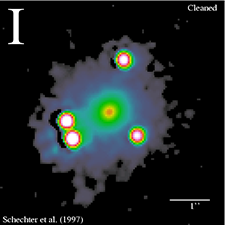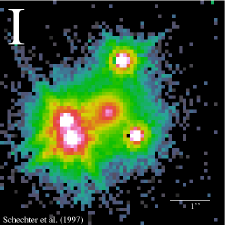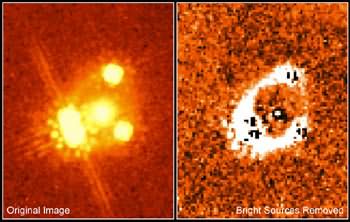The Einstein Cross is an excellent example of a probable quadruple quasar system described as a distant gravitational lens by current mainstream scientists. In fact, there are many good examples of multiple quasars that surround and even appear to be ejected from dimmer, lower redshift central galaxies. But unfortunately these objects too have been explained away as gravitational lenses, despite their lack of correlation with any known optical physics.
Take for instance PG1115+080 near the constellation Leo. This object also consists of four quasars surrounding a dimmer, lower redshift core. This central host galaxy displays a redshift of 0.31 z which supposedly places it over 2.9 billion light years away using a so-called Hubble Constant value of 85 (km/s)/Mpc. The four quasars display identical redshifts of 1.7355 z each which supposedly place them at a much greater distance of almost 8.3 billion light years also using a so-called Hubble Constant value of 85 (km/s)/Mpc.

Interestingly enough, most images of PG1115+080 show a tenuous connection between the central galaxy and one or more of the surrounding quasars, despite their accepted separation of over 5 billion light years. In the above images from the 8.2 meter Subaru Telescope at the Mauna Kea Observatory in Hawaii filaments of various thicknesses are shown connecting the central galaxy with all four of the surrounding quasars! 
 The following image on the left is from the CfA-Arizona Space Telescope LEns Survey (CASTLES). CASTLES utilized Hubble Space Telescope optical and near infrared images using NICMOS/NIC2 for H band observations and WFPC2/PC1 for V and I band images when otherwise unavailable. The image also shows all four quasars connected to the central galaxy via tenuous bridges of material. Even after the image is “cleaned” using image filtering software based on hypothetical gravitational lens models the two paired quasars at the lower left of the image on the right still display strong connections while very faint filaments are still visible between the other two quasars.
The following image on the left is from the CfA-Arizona Space Telescope LEns Survey (CASTLES). CASTLES utilized Hubble Space Telescope optical and near infrared images using NICMOS/NIC2 for H band observations and WFPC2/PC1 for V and I band images when otherwise unavailable. The image also shows all four quasars connected to the central galaxy via tenuous bridges of material. Even after the image is “cleaned” using image filtering software based on hypothetical gravitational lens models the two paired quasars at the lower left of the image on the right still display strong connections while very faint filaments are still visible between the other two quasars.
 Despite this evidence there are still scientists who try to manipulate the data. The pair of infrared images on the left is taken from the Hubble Space Telescope NICMOS. The left image is the original while the right image has supposedly had the quasars and central galaxy digitally subtracted from it to reveal a lensed galaxy in the background. There are a few problems with this processed image however. Besides the dubious method of subtraction used to create the image, the resulting ring of light is incomplete and irregularly shaped and does not conform to any accepted
Despite this evidence there are still scientists who try to manipulate the data. The pair of infrared images on the left is taken from the Hubble Space Telescope NICMOS. The left image is the original while the right image has supposedly had the quasars and central galaxy digitally subtracted from it to reveal a lensed galaxy in the background. There are a few problems with this processed image however. Besides the dubious method of subtraction used to create the image, the resulting ring of light is incomplete and irregularly shaped and does not conform to any accepted  optical physics or gravitational lens models. The image to the right is a 7+ hour exposure of PG1115+080 made by the Chandra X-Ray Observatory. If the light from a background quasar and its host galaxy is supposedly being lensed and is showing as a ring in infrared and possibly visible wavelengths why is there no trace of the hosting galaxy when it is viewed in the x-ray portion of the electromagnetic spectrum? The most likely explanation is that there is no real ring nor any gravitational lensing occurring at all other than what scientists so desperately wish to see rather than face the stunning reality of their observations.
optical physics or gravitational lens models. The image to the right is a 7+ hour exposure of PG1115+080 made by the Chandra X-Ray Observatory. If the light from a background quasar and its host galaxy is supposedly being lensed and is showing as a ring in infrared and possibly visible wavelengths why is there no trace of the hosting galaxy when it is viewed in the x-ray portion of the electromagnetic spectrum? The most likely explanation is that there is no real ring nor any gravitational lensing occurring at all other than what scientists so desperately wish to see rather than face the stunning reality of their observations.
If the four quasars encircling the central galaxy in PG1115+80 are not the result of gravitational lensing then what can account for their number and positioning? Why are quasars typically only located in a limited number of positions around the central galaxy in other compact quadruple quasar systems? One very interesting theory is that these quasars have been ejected from the central galaxy in a symmetrical tetrahedral pattern. The various filaments and connections observed between the quasars and the central galaxy in PG1115+80, the Einstein Cross and other quadruple quasar systems appears to confirm the ejection part of the theory. But I must admit I have always had trouble visualizing a tetrahedron configuration for the quasars in these compact systems. That was until one of my readers posted a comment under the Einstein Cross example. He suggested the humble methane molecule as a visual aid for tetrahedral symmetry. Of course it is not being suggested that methane plays any role in quadruple quasar systems. But the four hydrogen atoms that surround the central carbon atom in methane are positioned at the vertices of an imaginary tetrahedron orthographically projected from the central carbon atom. By rotating this tetrahedron the hydrogen atoms can be positioned so that they align themselves very closely with the majority of the quasar positions observed in compact quadruple quasar systems such as PG1115+80 and the Einstein Cross.
 The best way to view these alignments is to utilize a Java applet such as Jmol that allows viewing and manipulation of various molecules in orthographic perspective. The easiest way to accomplish this is to search for “JMOL methane” in any search engine. This query will return a variety of pages displaying the methane molecule in an embedded viewer. By rotating the methane molecule displayed in one of these Java viewers I was able to line up the angles of the hydrogen atoms to almost precisely match the angles of the quasars surrounding the core of PG1115+80 in the above observations. Any variance from the resulting image on the left is possibly due to the viewing angle and/or independent motion of the quasars since their ejections from the core. I was also able to rotate the methane molecule to align its hydrogen atoms precisely with the positions of the quasars shown in the Einstein Cross. Please be sure to visit this previously posted example to view the newly added resultant image.
The best way to view these alignments is to utilize a Java applet such as Jmol that allows viewing and manipulation of various molecules in orthographic perspective. The easiest way to accomplish this is to search for “JMOL methane” in any search engine. This query will return a variety of pages displaying the methane molecule in an embedded viewer. By rotating the methane molecule displayed in one of these Java viewers I was able to line up the angles of the hydrogen atoms to almost precisely match the angles of the quasars surrounding the core of PG1115+80 in the above observations. Any variance from the resulting image on the left is possibly due to the viewing angle and/or independent motion of the quasars since their ejections from the core. I was also able to rotate the methane molecule to align its hydrogen atoms precisely with the positions of the quasars shown in the Einstein Cross. Please be sure to visit this previously posted example to view the newly added resultant image.
So if the aforementioned objects are indeed formed by the ejection of quasars in a symmetrical tetrahedral pattern from a central galaxy why this particular pattern? I proffer that the answer is simplicity. A tetrahedron has the least number of faces and angles of any geometric solid. Therefore, other than a pair, the least number of objects that can evenly encircle a central object with matching angles is four and only if they are positioned at the vertices of a tetrahedron. There are many more examples of tetrahedral symmetry displayed in compact quadruple quasar systems. I plan to post several more of these as time permits. In the meantime continue to question the accepted theories, doubt the explanations given, and search for the truth about our universe and modern cosmology. Thanks for reading!
Shannon
